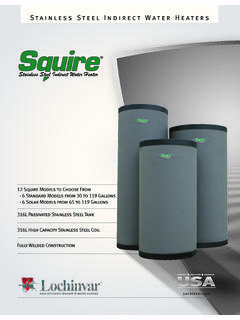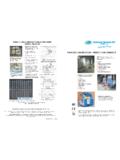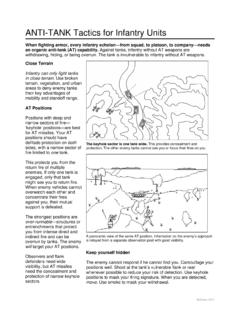Transcription of TOTAL WATER MANAGEMENT IN THE STEEL INDUSTRY
1 TOTAL WATER MANAGEMENT IN THE STEEL INDUSTRY By N. Ramachandran, Ion Exchange (India) Ltd Large quantities of WATER are required to produce STEEL and STEEL products - typically 180 - 200 m3 of WATER per ton of STEEL produced. Part of the WATER may be recycled - older units recycle upto 30 to 40 per cent and newer units up to 60 to 80 per cent of the WATER used. STEEL is made using any one of the following two routes The Blast furnace (BF)/Basic Oxygen Furnace (BOF) route: The blast furnace uses iron ore, coke and limestone to produce molten pig iron containing 4% to 5% carbon. A basic oxygen furnace converts pig iron into STEEL by reducing the carbon to less than one per cent by oxygen lancing.
2 Directly Reduced Iron (DRI)/Electric Arc Furnace (EAF) route: The process does not require expensive coke and produces solid directly reduced iron by removing oxygen from the ore using natural gas or coal. An Electric Arc Furnace produces STEEL by combining DRI with the scrap STEEL and reducing the carbon content . The composition of STEEL made from the primary STEEL making process is adjusted to suit the requirements of the customer in the secondary STEEL making process by oxidising unwanted elements like C and Si and by controlled addition of elements like Mn., Cr etc. in the Ladle Arc furnace. Gases entrained in the molten metal are removed by vacuum degassing and the composition made uniform by stirring the metal with argon gas WATER is used in the STEEL INDUSTRY for indirect cooling of primary and reheat furnaces, high pressure de-scaling of hot rolled products and for direct spraying on rollers and bearings, cooling of cold rolled products, wet scrubbing of furnace off-gases and for indirect cooling of the oxygen lance in the basic oxygen furnace and the copper mould in the continuous casting machines.
3 Part of the WATER is used for dust control in sinter feeds, slurrying and quenching iron ore and coal dust and slag in the blast furnace and as a solvent for acid in pickling, rinsing in coal rolling operation. The balance WATER is utilised in cooling and wet scrubbing of hot furnace gases. Furnace gases contain carbon monoxide and are reused as fuel for gas fired boilers and in waste heat recovery boilers. A small quantity of potable WATER is also used for drinking & sanitation. Direct Cooling WATER Circuits In the hot strip mill, high pressure WATER is sprayed on the hot rolled plates/coils as they move on the turnout table for de-scaling.
4 WATER is also sprayed to cool the rollers and bearings .The hot return WATER , laden with mill scale and lubricating oil, is drained into scale and medium sized mill scales are separated and sent to the sintering plant for recycle to the blast furnace. The overflow containing fine mill scale and oil is taken to a clarifier and or to a DynaSand continuous sand filter for removal of suspended solids. 1 Below is a cut away view of the DynaSand filter specifically developed for use in the STEEL INDUSTRY . Clarified and filtered WATER is recirculated back to the system though a cooling tower. Filtered WATER is added as tower operates at low cycles of concentration due to huge WATER losses due to direct evaporation.
5 Below is the schematic arrangement for direct cooling for de-scaling and roller cooling. Scale Pit Scale Pit Filter or Chemical treatment with Clarification R1 R6 Clarifier Cooling Tower Solids to sinter plant Solids to sinter plant Flume flushing WATER Roughing mill flume Finishing mill flume Sprays or Runout table and down boiler flume Roughing mills 1 to 6 stands Finishing mills 1 to 7 stands Runout Table Reheat Furnace 1300 C Down Coiler F1 F7 Descale Hot Strip Mill showing Recycle of Clarified WATER for Roll Cooling and Scale Removal indirect Cooling WATER Circuits The figure below shows the schematic arrangement of a continuous castor.
6 Molten metal is added into a ladle from where the metal is cast into billets, slabs or blooms through a tundish with an adjustable discharge device into a WATER cooled copper mould. The shape of the mould defines the shape of STEEL . Before casting the bottom of the mould is sealed with a dummy bar. As soon as the bath reaches its intended STEEL level, the mould starts to oscillate vertically in order to prevent the strand adhering to its walls. The red hot strand, solidified at the surface zones, is drawn from the mould, first with the aid of a dummy bar, and later by driving rolls. Because of its liquid core, the strand must be carefully sprayed and cooled down with WATER .
7 Rolls on all sides must also support it until it has completely solidified. This prevents the still thin rim zone from disintegrating. Once it has completely solidified, the strand can be divided by mobile cutting torches or shears. Intensive cooling leads to a homogenous solidified microstructure with favourable technological properties.. WATER used for mould cooling and for the sprays should be soft or demineralised and dosed with a copper corrosion inhibitor and is recycled back into the system in a closed circuit with minimal make up to allow for any loss in the system. Heat from the system is removed in a secondary cooling circuit incorporating a cooling tower.
8 Clarified and filtered WATER with low dissolved solids is added as make up to the secondary cooling WATER circuit. WATER used for direct spray must be absolutely free from suspended particles, as any accidental clogging of the sprays will result in unequal cooling of the surface resulting in rejection of the material and even serious damage to the equipment. The WATER used for spraying is collected from the bottom trough to remove scales and decant the oil. The overflow is taken to the nearest clarifier and filter before returning it to the cooling tower. Filtered WATER is continuously added as make up to the tower.
9 3 Cooling and Wet Scrubbing of Furnace Off-Gases One of the main applications of WATER in the STEEL INDUSTRY is for cooling and scrubbing of furnace gases from the blast furnance, basic oxygen furnace etc. The furnace gases are recovered and reused as fuel for the direct fired or waste heat recovery boilers for generation of steam. A charge of molten iron scrap and lime are placed on the BOF vessel and oxygen is introduced into the furnace through a WATER cooled oxygen furnace gases are scrubbed with WATER in the first venturi and again in the secondary venturi. The dirty WATER is collected and recycled back.
10 WATER consumption is minimised by contact of the dirty gas ladened with dirty WATER . It is then collected in a thickener, from where the bottom sludge containing iron oxide is taken to the sintering plant. Overflow from the thickener is taken to a holding tank where make-up is added. Below is a simplified flow diagram of the off gas scrubber system for basic oxygen process for STEEL making. The scrubbed WATER is highly alkaline with a pH of 12 13 and any attempt to add acid or makeup WATER into the system will result in heavy scaling. Hence, it is better to allow the system to operate at high pH and add make up WATER to the holding tank where precipitation may be allowed to occur.








